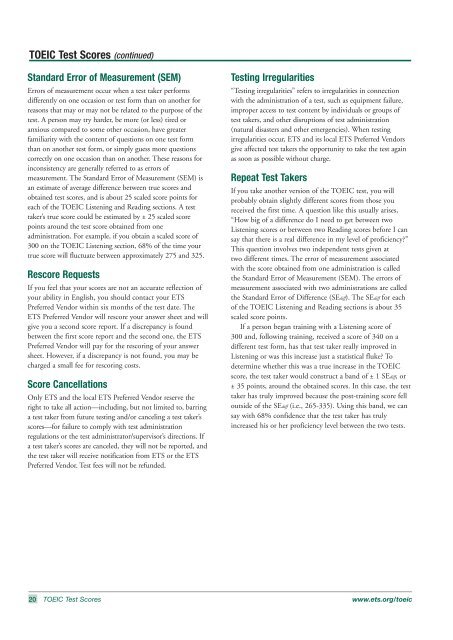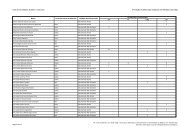continued - Curso - Universidade do Algarve
continued - Curso - Universidade do Algarve
continued - Curso - Universidade do Algarve
Create successful ePaper yourself
Turn your PDF publications into a flip-book with our unique Google optimized e-Paper software.
TOEIC Test Scores (<strong>continued</strong>)<br />
Standard Error of Measurement (SEM)<br />
Errors of measurement occur when a test taker performs<br />
differently on one occasion or test form than on another for<br />
reasons that may or may not be related to the purpose of the<br />
test. A person may try harder, be more (or less) tired or<br />
anxious compared to some other occasion, have greater<br />
familiarity with the content of questions on one test form<br />
than on another test form, or simply guess more questions<br />
correctly on one occasion than on another. These reasons for<br />
inconsistency are generally referred to as errors of<br />
measurement. The Standard Error of Measurement (SEM) is<br />
an estimate of average difference between true scores and<br />
obtained test scores, and is about 25 scaled score points for<br />
each of the TOEIC Listening and Reading sections. A test<br />
taker’s true score could be estimated by ± 25 scaled score<br />
points around the test score obtained from one<br />
administration. For example, if you obtain a scaled score of<br />
300 on the TOEIC Listening section, 68% of the time your<br />
true score will fluctuate between approximately 275 and 325.<br />
Rescore Requests<br />
If you feel that your scores are not an accurate reflection of<br />
your ability in English, you should contact your ETS<br />
Preferred Ven<strong>do</strong>r within six months of the test date. The<br />
ETS Preferred Ven<strong>do</strong>r will rescore your answer sheet and will<br />
give you a second score report. If a discrepancy is found<br />
between the first score report and the second one, the ETS<br />
Preferred Ven<strong>do</strong>r will pay for the rescoring of your answer<br />
sheet. However, if a discrepancy is not found, you may be<br />
charged a small fee for rescoring costs.<br />
Score Cancellations<br />
Only ETS and the local ETS Preferred Ven<strong>do</strong>r reserve the<br />
right to take all action—including, but not limited to, barring<br />
a test taker from future testing and/or canceling a test taker’s<br />
scores—for failure to comply with test administration<br />
regulations or the test administrator/supervisor’s directions. If<br />
a test taker’s scores are canceled, they will not be reported, and<br />
the test taker will receive notification from ETS or the ETS<br />
Preferred Ven<strong>do</strong>r. Test fees will not be refunded.<br />
Testing Irregularities<br />
“Testing irregularities” refers to irregularities in connection<br />
with the administration of a test, such as equipment failure,<br />
improper access to test content by individuals or groups of<br />
test takers, and other disruptions of test administration<br />
(natural disasters and other emergencies). When testing<br />
irregularities occur, ETS and its local ETS Preferred Ven<strong>do</strong>rs<br />
give affected test takers the opportunity to take the test again<br />
as soon as possible without charge.<br />
Repeat Test Takers<br />
If you take another version of the TOEIC test, you will<br />
probably obtain slightly different scores from those you<br />
received the first time. A question like this usually arises,<br />
“How big of a difference <strong>do</strong> I need to get between two<br />
Listening scores or between two Reading scores before I can<br />
say that there is a real difference in my level of proficiency?”<br />
This question involves two independent tests given at<br />
two different times. The error of measurement associated<br />
with the score obtained from one administration is called<br />
the Standard Error of Measurement (SEM). The errors of<br />
measurement associated with two administrations are called<br />
the Standard Error of Difference (SEdiff). The SEdiff for each<br />
of the TOEIC Listening and Reading sections is about 35<br />
scaled score points.<br />
If a person began training with a Listening score of<br />
300 and, following training, received a score of 340 on a<br />
different test form, has that test taker really improved in<br />
Listening or was this increase just a statistical fluke? To<br />
determine whether this was a true increase in the TOEIC<br />
score, the test taker would construct a band of ± 1 SEdiff, or<br />
± 35 points, around the obtained scores. In this case, the test<br />
taker has truly improved because the post-training score fell<br />
outside of the SEdiff (i.e., 265-335). Using this band, we can<br />
say with 68% confidence that the test taker has truly<br />
increased his or her proficiency level between the two tests.<br />
20 TOEIC Test Scores<br />
www.ets.org/toeic



